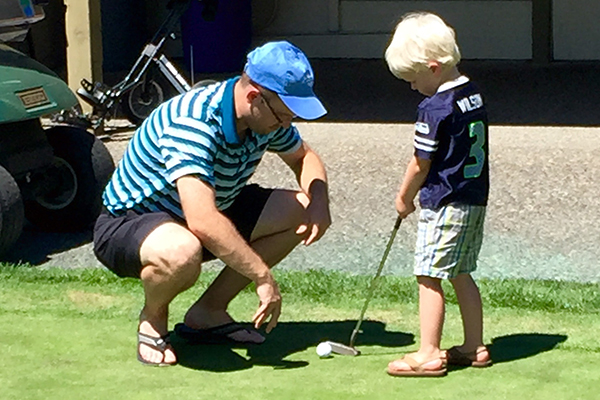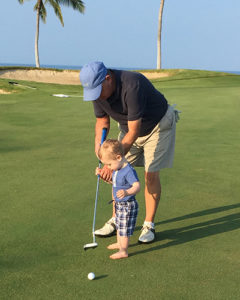by Jeff Tolman
I am blessed to have four happy, healthy, wonderful grandchildren, ages nine, seven, three and one. Hopefully, each will play golf when they are older. Through the game they will learn many positive lessons that will assist them in the years ahead.
Golf is great exercise, and is not hard on the joints. Hard on one’s ego, yes; joints, no. In an 18-hole round a player will walk five-and-a-half or six miles at a four-hour-or-so pace. Up and down hills. Burning off calories. Keeping one’s heart rate up. Almost always in gorgeous, well-kept surroundings. Golf will help keep them healthy.

Teamwork and helping others is part of the game. When any player hits a ball off the course, the other players will join together, traipsing into the woods or brambles or tall grass looking for the errant shot, helping each other.
An integral part of the game is taking turns. The player farthest out hits next. No matter how anxious or big or aggressive you are.
Golf encourages social interaction. Hit a shot, walk a hundred yards or so to the ball while conversing; hit a shot, walk a hundred yards or so to the ball conversing. Repeat. Pretty comfortable circumstances to chat and meet new people, all-in-all.
The game incorporates a near-spiritual silence into each round. Be quiet while others hit. They will be quiet when you are over the ball. The silence gives a player time to enjoy the course, the scenery, the camaraderie, the outdoors.

Every golfer is expected to leave the course as he or she found it, or better. Put sand on the divots you create. Clean up pitch marks on the green. As a Boy Scout might say, leave the campsite better than when you got there.
Golf teaches science. Broken down to its essence, golf is a game of physics. Loft + force = distance. Hit the ball at a certain angle and it will go where you want. Change the angle by club loft or swing angle and you can adjust your distance and shot height. It sounds like simple science to me. Though, as we all know, that is easier said than done.
Anger control is part of the culture. Sure, you’ll hit imperfect shots, but no throwing clubs, no swearing. No tantrums. Learning, and living, self-control is part of the golf experience.
Golfers learn to be resilient in failure, humble in success. Perhaps the cruelest part of golf is how it gives a golfer enough good shots in any round to think there’s a pretty good player somewhere in his or her body and head, so they’ll come back, but enough bad shots to remind social golfers not to quit their day job.
Golf is non-discriminatory. Anyone can play the game. Short or tall. Skinny or heavy. Blonde, brunette or bald. Right-handed or left-handed. Athletic or not-so-much.
The game is playable for a lifetime. There are few 70-year-olds still playing football. Golf is a doable, lifetime attraction.
And, after the round, no matter how the players finish, they doff their caps and shake hands, ending a positive shared experience on the links.
When my grandkids Kinzie, Miller, Zach and Emily are out on the course, I‘ll be the old guy watching and smiling. Delighted that through participation in a sport, they are learning so many valuable life lessons.
Jeff Tolman is a lawyer in Poulsbo, Wash. who has had over 400 articles published in nearly 60 publications about life and law and golf, which pretty much sums it up.
For more information on junior programs supported by the WSGA, click here.

